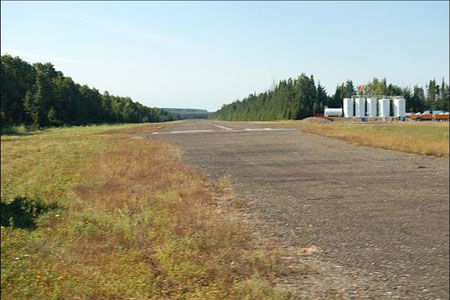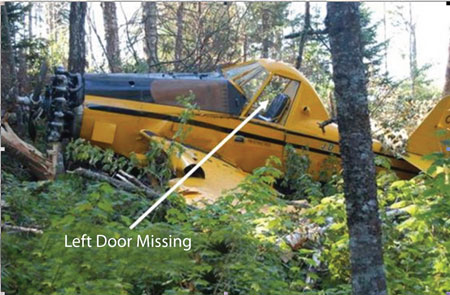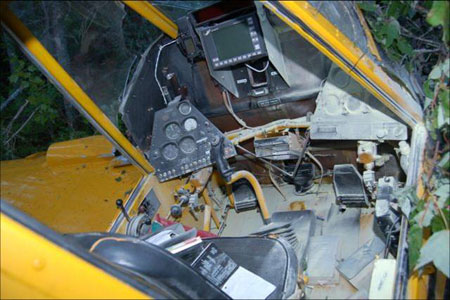Engine Failure/Forced Landing
Forest Patrol Limited
Ayres S-2R C-FBED
Boston Brook, New Brunswick
The Transportation Safety Board of Canada (TSB) investigated this occurrence for the purpose of advancing transportation safety. It is not the function of the Board to assign fault or determine civil or criminal liability. This report is not created for use in the context of legal, disciplinary or other proceedings. See Ownership and use of content. Masculine pronouns and position titles may be used to signify all genders to comply with the Canadian Transportation Accident Investigation and Safety Board Act (S.C. 1989, c. 3).
Summary
The privately-operated Ayres S-2R spray plane, (registration C-FBED, serial number 1767R) was returning to the Boston Brook, New Brunswick, airstrip after having completed the second spray-application flight of the day. The aircraft was at an altitude between 200 and 300 feet above ground level, approximately two nautical miles from the airstrip, when the engine began to run rough. At approximately 0813 Atlantic daylight time, the pilot contacted a company maintenance engineer by radio to report the problem. The engine then began to produce smoke and eventually it stopped running. A forced landing was carried out into a stand of trees at the edge of a cutover. The aircraft was substantially damaged and the pilot escaped injury. There was no post-impact fire.
Factual information
The pilot was certified and qualified for the flight in accordance with existing regulations. At the time of the occurrence, the weather was appropriate for spray operations with no wind or clouds present in the local area.
The pilot was transiting back to the base when the initial engine vibrations developed and he contacted a company maintenance engineer to report the problem. Shortly thereafter, he noticed white smoke exiting from the left side of the engine. Within seconds, his forward visibility was obscured by the smoke and the engine stopped operating. He initiated a left turn in the direction of a cutover. The suitability of the cutover as an emergency landing area was limited by a high concentration of tree stumps that would likely result in the aircraft nosing over on touchdown. With the aircraft quickly losing altitude, few options were available to the pilot so he maintained his heading and continued the forced landing into trees at the edge of the cutover.
As the aircraft entered the trees in a right-wing-low attitude, it began to decelerate and yaw further to the right. Several large trees were broken off in the accident sequence, which caused damage to both wings, the tail section, fuselage, empennage, propeller, and engine. The pilot, who was wearing a four-point safety harness, was not injured. The cockpit integrity was not compromised.
The pilot remained onboard the aircraft for a few minutes as he attempted to radio the company base. Between transmissions, the pilot could hear interference from the emergency locator transmitter (ELT) signal in his headset. This inhibited his ability to detect if anyone at the base had acknowledged the transmission. In an attempt to shut off the ELT and silence the interference, he tried to locate the unit, but without success. The ELT placard is located on the outside of the left-side cockpit door. The placard was not visible because the door had become detached from the aircraft and was lying on the forest floor with the placard side down.
On-site examination of the airframe revealed that all control surfaces were accounted for and all damage to the aircraft was attributed to the impact forces. The engine also sustained impact damage, which was limited to the respective cooling fins of a few cylinders. However, cylinder number five had a six-by-two-inch hole in it, with a portion of a connecting rod extending out of the hole. Although the propeller could be moved a few inches either way, the engine had seized completely. The engine was removed and transported to the TSB Engineering Laboratory where it was torn down completely for further examination.
Propeller damage and bending was consistent with little or no power being produced at the time of impact. All engine controls were in proper working order and securely attached. The engine oil reservoir contained an appropriate amount of oil and the oil filter screens were free of contaminants. Fuel remaining in both wing tanks was uncontaminated and of the recommended grade. The fuel and oil lines were intact and connected. All accessory section components were attached and secure.
The valve train and upper portion of each cylinder was intact and did not contribute to the engine failure. The accessory section gears were found intact, secure, and undamaged. The tops of each piston did not show any signs of damage from detonation or pre-ignition. Once the cylinders were removed, it was noted that every connecting rod and the underside of each piston and cylinder base had been subjected to severe damage. Two connecting rods, number one and number nine, were broken off from their respective piston at the wrist pin end. The remaining seven connecting rods, numbers two through eight, had broken off in closer proximity to the main bearing end. Fracture surfaces of the connecting rods were examined. The damage to connecting rod number five was so severe that the mode of failure could not be determined.
The engine, a Pratt & Whitney Wasp R1340, serial number 8565, was installed in C-FBED in January 1993. Although the exact date could not be determined, records indicate that the engine had entered service prior to 1967. Since that time, the engine had gone through two complete overhaul cycles and had accumulated 2162 hours since new. The time before overhaul for the engine is set by the engine manufacturer at 800 hours. At the time of the failure, it had accumulated 797.6 hours since the last major overhaul. Only 2.4 hours remained before the engine was due to be removed for overhaul.
The aircraft was manufactured in 1973, and had accumulated 3593.8 hours at the time of the accident. It was certified and maintained in accordance with existing regulations and approved procedures. The aircraft's weight and centre of gravity were within the prescribed limits.
Analysis
When the engine began to vibrate, the pilot attempted to identify and rectify the problem. He was not successful as there was very little time from the first indication of engine trouble to when the engine stopped completely. Under these circumstances, the pilot had no choice but to conduct a forced landing. The aircraft had only reached an altitude of approximately 200 to 300 feet above ground following completion of the spray task when the engine began to run rough. This left the pilot with little time to prepare for the forced approach or to select a more suitable landing area.
Examination of the engine showed that it contained sufficient lubricating oil and that the oil filter screens were free of metal particles or other contamination. This indicates that the engine was not making metal prior to the failure. Therefore, the imminent failure would not have been detectable during routine maintenance activity. Oil supply and engine maintenance were not a factor in the failure. The propeller, valve train, and accessory gearbox sections of the engine did not contribute to the engine failure.
The damage to cylinder number five suggests that the associated connecting rod failed first in the sequence. It then penetrated the cylinder sleeve as the engine continued to operate. The failure initiated a chain of overload failures for each of the remaining connecting rods in rapid succession until the engine stopped operating. Due to the severity of damage to the fracture surfaces of connecting rod number five, the mode of failure could not be determined.
Findings as to Causes and Contributing Factors
- Connecting rod number five failed for undetermined reasons. This failure initiated a sequence that resulted in the overload failure of the remaining connecting rods.
- When the engine failed, the pilot had little time to prepare for the forced approach due to the low altitude of the aircraft.
This report concludes the Transportation Safety Board's investigation into this occurrence. Consequently, the Board authorized the release of this report on .


